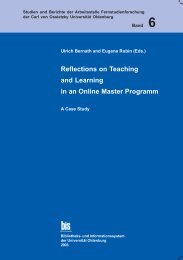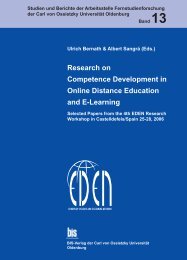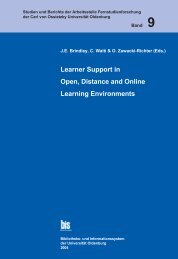Distance Education in Transition - Master of Distance Education ...
Distance Education in Transition - Master of Distance Education ...
Distance Education in Transition - Master of Distance Education ...
You also want an ePaper? Increase the reach of your titles
YUMPU automatically turns print PDFs into web optimized ePapers that Google loves.
Introduction<br />
Ow<strong>in</strong>g to the exponential expansion <strong>of</strong> distance education dur<strong>in</strong>g the last decade the<br />
<strong>in</strong>terest <strong>in</strong> this particular form <strong>of</strong> learn<strong>in</strong>g and teach<strong>in</strong>g has grown <strong>in</strong> a remarkable way<br />
<strong>in</strong> many countries all over the world. Never before were there so many persons<br />
weigh<strong>in</strong>g the pros and cons <strong>of</strong> this form <strong>of</strong> learn<strong>in</strong>g and teach<strong>in</strong>g, never before were so<br />
many respective experiments conducted <strong>in</strong> this field, and never before were there so<br />
many new protagonists <strong>of</strong> this form <strong>of</strong> learn<strong>in</strong>g and teach<strong>in</strong>g. Now even experts outside<br />
the field <strong>of</strong> traditional distance education see its unique possibilities, a trend which can<br />
be observed most clearly at national and <strong>in</strong>ternational conferences on this field <strong>of</strong><br />
educational activity. Also traditional universities start experiment<strong>in</strong>g with distance<br />
education after a long period <strong>of</strong> ignor<strong>in</strong>g this method <strong>of</strong> teach<strong>in</strong>g and learn<strong>in</strong>g. As Tony<br />
Bates (1997, p. 93) put it: „While the establishment <strong>of</strong> the Open University <strong>in</strong>itially<br />
made little impact upon established universities and colleges, most <strong>of</strong> whom were quite<br />
happy to ignore it, this time technological change is strik<strong>in</strong>g at the very heart <strong>of</strong><br />
conventional schools, colleges and universities." Indeed, many f<strong>in</strong>d it reasonable not<br />
only to develop electronic forms <strong>of</strong> distance learn<strong>in</strong>g, but also to establish new divisions<br />
for distance education. Even Oxford University is l<strong>in</strong>k<strong>in</strong>g with Stanford, Yale and<br />
Pr<strong>in</strong>ceton to create an onl<strong>in</strong>e college for alumni. The idea is to provide lifelong learn<strong>in</strong>g<br />
and support to some <strong>of</strong> the world’s policy makers and bus<strong>in</strong>ess leaders. Cambridge is<br />
explor<strong>in</strong>g virtual learn<strong>in</strong>g <strong>in</strong> its £ 83 million government-backed l<strong>in</strong>k up with the<br />
Massachusetts Institute <strong>of</strong> Technology (MIT). The project is known as “the bridge <strong>of</strong><br />
m<strong>in</strong>ds” and is pr<strong>in</strong>cipally <strong>in</strong>tended to foster commercial sp<strong>in</strong>-<strong>of</strong>fs from university<br />
research. It also has the potential to become an e-university.” (Bates, 2001, p. 32). Also<br />
the unparalleled upsurge <strong>of</strong> publications and the rapid growth <strong>of</strong> the number <strong>of</strong> sem<strong>in</strong>ars,<br />
workshops, and symposiums deal<strong>in</strong>g with current problems <strong>of</strong> distance education are<br />
ample pro<strong>of</strong> <strong>of</strong> this trend.<br />
The ma<strong>in</strong> reason for the rapidly <strong>in</strong>creas<strong>in</strong>g <strong>in</strong>terest <strong>in</strong> distance education are, <strong>of</strong> course,<br />
the unbelievable advances <strong>of</strong> telecommunication. Its digitalisation confronts teachers<br />
and schools with unpredicted, unforeseeable and surpris<strong>in</strong>g promises. Especially for<br />
distance educators four astound<strong>in</strong>g <strong>in</strong>novations are important: improved personal<br />
computer technology, multimedia technology, digital video-compression technology and<br />
Internet technology. Together with other technologies they make possible unexpected<br />
logistic and pedagogical advantages: the quick delivery <strong>of</strong> <strong>in</strong>formation at any time and<br />
everywhere, genu<strong>in</strong>e possibilities for autonomous learn<strong>in</strong>g, more <strong>in</strong>teractivity, more<br />
learner-orientation, more <strong>in</strong>dividualisation, better quality <strong>of</strong> programmes, and greater<br />
learn<strong>in</strong>g effectiveness.<br />
What does this mean <strong>in</strong> the concrete learn<strong>in</strong>g situation <strong>of</strong> distant learners? They are<br />
provided with the possibility and are enabled to learn „face-to-face at a distance“ (Keegan,<br />
1995, p. 108). And – as if by magic – many new virtual ways <strong>of</strong> contact<strong>in</strong>g persons<br />
everywhere „quickly, easily, safely and cheaply“ (Hawkridge, 1995a, p. 5) are available.<br />
This means e.g. that also distant learners are <strong>in</strong> a position to exchange views, discuss<br />
problems, and take part <strong>in</strong> scientific discourses, tutorials, and counsell<strong>in</strong>g sessions.<br />
Likewise they even may take oral exam<strong>in</strong>ations and chat with fellow students or with<br />
persons <strong>in</strong>terested <strong>in</strong> the subjects to be learned <strong>in</strong> other countries. New dimensions for<br />
the pedagogy <strong>of</strong> distance education are opened up and compensate for certa<strong>in</strong> deficiencies<br />
11





